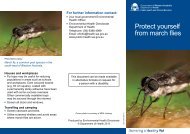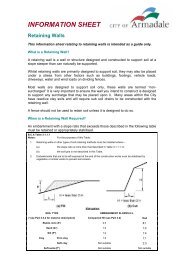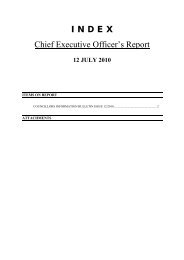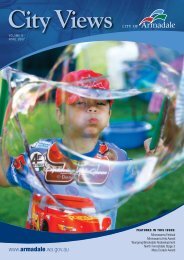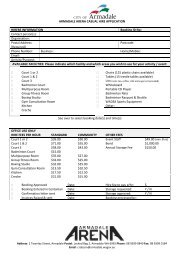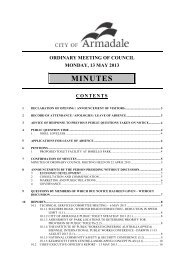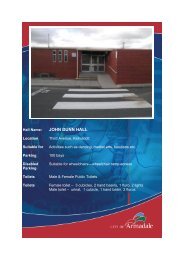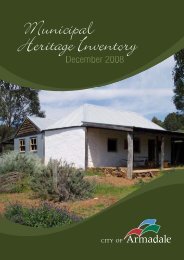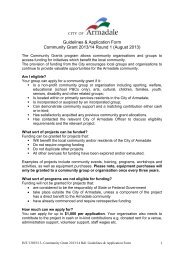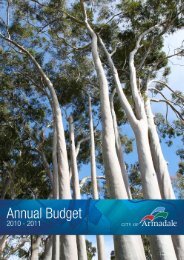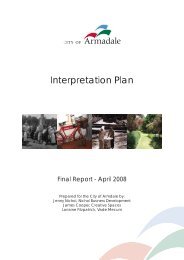Bulletin (PDF 18.3 MB) - City of Armadale
Bulletin (PDF 18.3 MB) - City of Armadale
Bulletin (PDF 18.3 MB) - City of Armadale
Create successful ePaper yourself
Turn your PDF publications into a flip-book with our unique Google optimized e-Paper software.
Information <strong>Bulletin</strong>Correspondence & PapersPage Cor-29The new specifications were developed by ARRB Group, peer reviewed by GHD'sGeotechnical Division and funded by the Australian Food and Grocery Council's PackagingStewardship Forum (PSF).Through partnerships between the PSF, local government and industry there are alreadyseveral sites nationwide demonstrating that using recycled crushed glass in roads andpavements provides a cost effective local solution for dealing with recovered glasscontainers.In Victoria, Manningham and Brimbank Councils have constructed new bicycle andpedestrian pathways using a 100 percent recycled mix <strong>of</strong> crushed glass and crushed rock.Both councils have laid a total <strong>of</strong> 340 metres <strong>of</strong> pathways using recycled crushed glass in thesub base, the main load bearing layer <strong>of</strong> the pathways. In Tasmania, Clarence <strong>City</strong> Councilhas designed, developed and managed the construction <strong>of</strong> a car park at the Rosny TennisClub using recycled crushed glass in pipe bedding, asphalt, sign pole footings, concretefootpaths, kerbing and guttering.In NSW, Waverley Council has constructed two 100 metre sections <strong>of</strong> an asphalt andconcrete road in Bondi, designed and approved by the Road Transport Authority NSW usingrecycled crushed glass. In total these project have diverted the equivalent <strong>of</strong> 920,000stubbies from landfill.For copies <strong>of</strong> the new specifications or for further recycled crushed glass information pleasecontact Chris Jeffreys, Program Manager Glass Recovery & Recycling, on 0403 486 454 orchris.jeffreys@afgc.org.auFrom the PresidentIt is no secret that I am passionate about is planning, and the principle <strong>of</strong> local communitieshaving a strong voice in local planning decisions.It was pleasing to read the recent Grattan Institute's second Cities program report titled"Cities: Who Decides?"In summary, the report investigates decision making in eight <strong>of</strong> the world's most successfulcities, and asks what governance arrangements accompanied their broad-basedimprovement.Not surprisingly every city has a different story, but among these differences are a number<strong>of</strong> common themes. These included the importance <strong>of</strong> public engagement, consistentstrategic direction, cross-sectoral collaboration, and regional cooperation.The report's findings have a number <strong>of</strong> implications for Australian cities, and I agree withthe Grattan Institute that two stand out. Firstly, residents must be involved in decisions andsecondly, changing structures does not guarantee success in itself and indeed may be just adistraction. Although no one particular type <strong>of</strong> governance structure was associated withcities' improvement, an important finding was that any structural change must be coupledwith early and deep public engagement.A long line <strong>of</strong> ALGA President's, especially my predecessor, Cr Ge<strong>of</strong>f Lake, has made theseexact statements to a variety <strong>of</strong> Commonwealth and State Ministers, and also in forums suchas the Local Government and Planning Ministers' Council and the Housing Ministers' Council.



